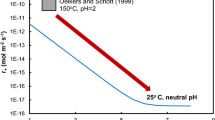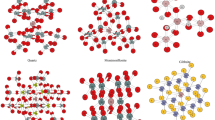Abstract
Analytical data from aqueous dissolution studies of minerals, mineral systems, and naturally equilibrated solutions such as surface waters and groundwaters provide the basic ingredients necessary to calculate comparative solubility (or activity) products (CKs) and comparative free energies of formation (CΔGf0) of possible minerals or hypothetical minerals. Using a thermodynamic approach, quasi-thermodynamic values are obtained which can help in understanding the relative stabilities of different but similar materials and changes in reacting systems. Illite equilibrated solutions demonstrated that: 1) there is a 5 kcal spread in comparative free energies of formation of the five illites used, 2) the comparative stabilities remain about the same when highly simplified but similar hypothetical mineral formulas are considered, and 3) some of these illites are probably not the most stable phase in a closed chemical system at standard temperature and pressure.
A “mineral index system” composed of common rock-forming minerals, products of chemical weathering and perhaps hypothetical minerals is proposed, which offers a means of studying naturally equilibrated solutions. Such a system can show changes with respect to CΔGf0 of these minerals at a particular site through time or in relationship to spatial distribution and geologic changes through synchronous sampling at different sites.
Резюме
Аналитические данные изучения результатов растворения минералов и минеральных систем в воде, а также изучение естественных уравновешенных растворов, таких как поверхностные и подземные воды, обеспечивают основные составляющие, необходимые для вычисления параметров относительной растворимости, или активности,(CKS)и относительных свободных энергий формирования (C G°f) возможных минералов или гипотетических минералов. Используя термодинамический подход, могут быть получены квазитермодинамические значения, которые помогают понять относительную стабильность различных, но сходных материалов и изменения в реакционных системах. Иллитовые уравновешенные растворы показали, что: 1) 5 ккал относительно свободной энергии необходимо для формирования пяти иллитов, 2) относительная стабильность остается примерно той же, когда рассматриваются упрощенные, но сходные гипотические формулы минералов, и 3) некоторые из этих иллитов возможно не являются наиболее стабильной фазой в закрытой химической системе при стандартных температурах и давлении.
Предлагается “минеральная индексная система”, состоящая из обычных породообразующих минералов, которая может служить средством изучения естественных уравновешенных растворов. Такая система может выявлять изменения, касающиеся C G°f этих минералов в отдельных местах с течением в ремени или по отношению к пространственному распределению и геологическим изменениям при одновременном отборе образцов из различных мест.
Kurzreferat
Analytische Meßdaten,aus Auflösungsversuchen in Wasser von Mineralien, Mineralsystemen und natürlich equilibrierten Lösungen wie Oberflächen-und Grundwasser, stammend, liefern die grundlegenden Bestandteile notwendig für die Berechnung der relativen Löslichkeits-(oder Aktivitäts) Produkte und der relativen Freien Bildungsenergien von Mineralien oder hypothetischen Mineralien. Indem eine thermodynamische Methode benutzt wurde, wurden quasi-thermodynamische Werte erhalten, die helfen, die relativen Stabilitäten von verschiedenen aber ähnlichen Materialien und Veränderungen in reagierenden Systemen, zu verstehen. Mit Illiten equilibrierte Lösungen demonstrieren das folgende: 1) es existiert eine 5 kcal Spanne in relativen Freien Bildungsenergien unter den 5 benutzten Illiten, 2) die relativen Stabilitäten bleiben ungefähr die gleichen, wenn sehr simplifizierte aber gleichartige, hypothetische Mineralformeln erwägt werden, 3) einige dieser Illiten sind wahrscheinlich nicht die stabilste Phase in einem geschlossenen, chemischen System bei Standart-Temperatur und Druck.
Résumé
Les données analytiques obtenues d’etudes de dissolution aqueuse de minéraux, de systèmes minéraux et de solutions naturellement équilibrées telles des eaux de surface et de la nappe phréatique procurent les éléments nécéssaires de base pour calculer les produits de solubilité (ou d’activité) comparative(CKS) et les énergies libres comparatives de formation(CΔG°f) de minéraux possibles ou de minéraux hypothétiques. Par l’emploi d’une approche thermodynamique, des valeurs quasi-thermodynamiques sont obtenues, valeurs qui aident à comprendre les stabilités relatives de matériaux différants mais similaires, et les changements dans les systèmes réagissants. Les solutions équilibrées à l’illite montrent que 1) il y a un étalage de 5 kcal. dans les énergies libres comparatives de formation des 5 illites utilisées, 2) les stabilités comparatives sont maintenues à peu près égales lorsqu’elles sont fort simplifiées, mais des formules de minéraux hypothétiques semblables sont considérées, 3) certaines de ces illites ne sont probablement pas la phase la plus stable dans un système chimique fermé à température et pression standards. Un “système d’index minéral” composé des minéraux communément formant des roches, les produits d’altération chimique, et peut-être des minéraux hypothétiques est proposé, système qui offre un moyen d’étudier les solutions équilibrées naturellement. Un tel système peut montrer des changements vis à vis du CΔG°f de ces minéraux à un site particulier pendant un certain lapse de temps, ou vis à vis de distribution spatiale et de changements géologiques par des échantillonages synchroniques à différants sites.
Similar content being viewed by others
References
Gaudette, H. E., Eades, J. D. and Grim, R. E. (1966) The nature of illite: Clays & Clay Minerals 13, 33–48.
Goldich, S. S. (1938) A study in rock weathering: J. Geol. 46, 17–58.
Helgeson, H. C. (1968) Evolution of irreversible reactions in geo-chemical processes involving minerals and aqueous solution—I. Thermodynamic relations: Geochim. Cosmochim. Acta 32, 853–877.
Helgeson, H. C. (1969) Thermodynamics of hydrothermal systems at elevated temperatures and pressures: Am. J. Sci. 267, 729–804.
Huang, W. H. and Keller, W. D. (1972) Standard free energies of formation calculated from dissolution data using specific mineral analyses: Am. Mineral. 57, 1152–1162.
Jackson, J. L. and Sherman, G. D. (1953) Chemical weathering of minerals in soils: Adv. Agron. 5, 219–318.
Nriagu, J. O. (1975) Thermochemical approximations for clay minerals: Am. Mineral. 60, 834–839.
Reesman, A. L. and Keller, W. D. (1967) Chemical composition of illite: J. Sediment. Petrol. 37, 592–596.
Reesman, A. L. and Keller, W. D. (1968) Aqueous solubility studies of high alumina and clay minerals: Am. Mineral. 53, 929–942.
Reesman, A. L. (1974) Aqueous dissolution studies of illite under ambient conditions: Clays & Clay Minerals 22, 443–454.
Reiche, P. (1943) Graphical representation of chemical weathering: J. Sediment. Petrol. 13, 58–68.
Robie, R. A. and Waldbaum, D. R. (1968) Thermodynamic properties of minerals and related substances at 298.15°K (25.0°C) and one atmosphere (1.013 Bars) pressure and at higher temperatures: U.S. Geol. Surv. Bull. 1259, 256pp.
Tardy, Y. and Garrels, R. M. (1974) A method for estimating the Gibbs energies of formation of layer silicates: Geochim. Cosmochim. Acta 38, 1101–1116.
Author information
Authors and Affiliations
Rights and permissions
About this article
Cite this article
Reesman, A.L. Extrapolation of Aqueous Dissolution Data to Determine Comparative Free Energies of Formation (CΔGf0), and Relative Mineral Stabilities. Clays Clay Miner. 26, 217–226 (1978). https://doi.org/10.1346/CCMN.1978.0260305
Received:
Published:
Issue Date:
DOI: https://doi.org/10.1346/CCMN.1978.0260305




